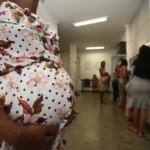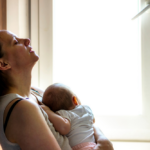Essay contest: Unexpected beginnings
From the sweet and touching to the funny and unforgettable, […]

“You’re showing signs of early labor. I think it’s best to go straight to the hospital.” My doctor’s voice is both apologetic and matter-of-fact, the way the maître d’ tells you the kitchen is closed.
“Will I be home for Christmas?” I ask him, thinking of the stocking stuffers I’d bought for my 3-year-old daughter.
He purses his lips and points to the ultrasound monitor, clicking through several grainy slides of my twins.
He says, shrugging: “Christmas is what—three days from now? We’ll admit you to see how things are going. Then we can see.”
I hear: “Of course you’ll be home for Christmas. This is just a precaution because we doctors like to overreact.”
I ask: “Can I go home first and get some things? I live just a few minutes away from here.”
The doctor, the nurse and the ultrasound technician exchange glances. My husband, who has been leaning against the wall of the examination room, slides slowly down to a crouch. He hangs his head in his hands. Then his head droops forward onto his chest.
The nurse shuffles through some drawers and brings out smelling salts.
“Do you have a bag packed?” she casually asks, waving the open vial under my husband’s nose.
I shake my head. The twins aren’t due until Easter.
“Then you should just go straight to the hospital.”
The doctor holds a hand out to my husband and helps him to his feet. He pats him on the back.
“Whenever you’re ready, dad.” One week later the contractions start. When they are five minutes apart and lasting longer than a minute, the nurses wheel me to the labor and delivery ward where nine doctors and nurses stand ready to take care of my boys as soon as they take their first breaths. The twins are born within the hour. Before I can even see them, my babies are whisked off to the NICU where they will live for the next three months.
“Just rest,” the nurse tells me. “You can see your babies tomorrow.”
I have been lying down for eight days. My legs prickle as the anesthesia wears off. I retch. More side effects of the anesthesia. I try to vomit carefully; I don’t want split the stitches from the emergency C-section.
That night my husband brings me pictures. In them, the first baby—the one born with his umbilical cord wrapped twice around the neck—is bright red. He looks to be in mid-scream, a good sign for someone with underdeveloped lungs. He weighs little more than a pint of ice cream. His arm is the size of my husband’s finger. I call him The Red Baby. His brother—The Blue Baby—was born with a knot in his umbilical cord. In his birth photo The Blue Baby is slumped over. His head and face are bruised and his skin looks slimy, like a raw chicken breast.
For 25 weeks, my babies and I were one. I nourished them. I protected them. My blood was their blood. Now my role is played by technology and trained professionals. The hospital room is a giant, artificial womb. The nurses are surrogate mothers. I am only a guest.
The machines are loud and overwhelming, accompanied by beeping alarms and flashing lights. It’s supposed to be dark and quiet and warm but there’s always some light; there’s always some noise; I’m always freezing. There’s the incessant glow of the monitors. The machines constantly whir in a loud whisper. I don’t know where the draft comes from but I can always feel it on the back of my neck, as if the whole room were trying to get my boys to breathe.
The doctors and nurses go to great lengths to make parents feel at home here. They apologize for the bulky life-support machines, assuming that all parents find them scary. To me, the machines are just a necessary annoyance, like traffic.
What really bothers me is the tape on my babies’ skin. There’s so much tape. There’s tape to secure the breathing tubes that are crammed down the boys’ throats, tape on the feeding tubes that snake into their stomachs through their noses, and tape where the IVs have punctured the skin. There’s tape on my babies’ cheeks, chins, arms and legs, tape on skin that is newer than newborn—skin so fragile that it bruises from the sheer burden of being alive.
I can’t do anything about the breathing tubes (the boys need to breathe) or the feeding tubes (they need to eat). I can’t do anything about the transfusions (I know they need more blood). I can’t do anything about their morphine drip (I can see they’re in pain after their surgeries). But I wish I could do something about all that tape.
The boys’ joints are stiff; their bones are brittle. The lobes of their ears are folded over like the corners of a dinner napkin. The sides of their heads are flat from lying on their stomachs with their clay-soft skulls turned to one side. The nurses call it “toaster head” because their heads resemble the shape of an old-fashioned toaster.
“Do you have any questions?” The doctors try to explain the boys’ condition to me. What a blood-gas reading is. What it means to have “sticky lungs.” Why my babies get daily doses of caffeine. But I don’t want explanations; I want a crystal ball.
I summon strength by cracking jokes.
“You’re handling this so well!” the nurses comment.
At night, through the walls of the family lounge, I hear a mother’s uncontrollable sobs.
Twenty-six days pass before the boys are stable enough to trigger the question I’ve been waiting for: “Would you like to hold your baby?”
The doctor gestures to the baby closest to me: The Blue Baby. Three nurses work in tandem to disconnect—then reconnect—various tubes and tape-affixed sensors as they move The Blue Baby out of his climate-controlled isolette and ease the two of us into a rocking chair. One of the nurses tapes the slack from the tubes to the fresh, clean hospital gown that I wear specifically for the purpose of holding my baby.
The Blue Baby snuggles into my skin, like he knows me. My baby knows me. I cradle his head and he grasps the tip of my thumb. The moons of his fingernails are pink. His hair is wavy. He has a sweet smell, a baby’s smell. When he smacks his lips I can see tiny taste buds on his tongue. Alone in his isolette, he might seem like a flickering candle, but with his head nestled on my breast, he could be a generator for the sun.
I can tell: He’s not mad or sad or ruined. He’s happy and cuddly, as if we do this every day. As if it doesn’t matter that he’s 26 days old and has never been held before. As if he’s reassuring me that we can’t change the past and that the future will be what it will be. Reminding me that all we have is this moment and that a mother holding her baby is about as good as it gets. It’s so much better than forgiveness because he doesn’t acknowledge any transgressions.
Across from us, the bedside nurse files paperwork. I wonder if she can hear us purr.








